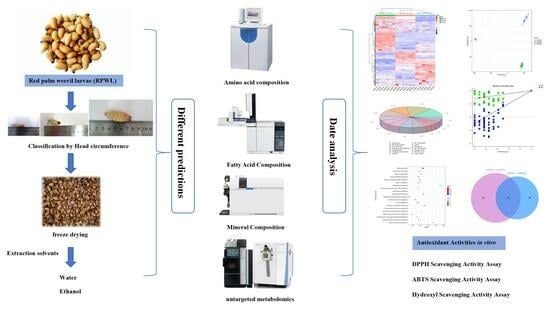Combined Analysis of Metabolomics and Biochemical Changes Reveals the Nutritional and Functional Characteristics of Red Palm Weevil Rhynchophus ferrugineus (Coleoptera: Curculionidae) Larvae at Different Developmental Stages
Abstract
:Simple Summary
Abstract
1. Introduction
2. Materials and Methods
2.1. Samples Preparation
2.2. Determination of Chemical Composition
2.3. Determination of Amino Acid Composition
2.4. Determination of Fatty Acid Composition
2.5. Determination of Mineral Composition
2.6. Determination of Untargeted Metabolomics
2.6.1. Metabolite Extraction
2.6.2. LC-MS/MS Analysis
2.6.3. Data Preprocessing
2.7. Antioxidant Activities In Vitro of RPW Larvae Extract
2.7.1. Preparation of RPW Larvae Extract
2.7.2. DPPH Radical-Scavenging Activity Assay
2.7.3. ABTS Radical-Scavenging Activity Assay
2.7.4. Hydroxyl Radical-Scavenging Activity Assay
2.8. Statistical Analysis
3. Results and Analysis
3.1. Analysis of Chemical Composition
3.2. Amino Acid Composition Analysis
3.3. Analysis of Fatty Acid Composition
3.4. Minerals Composition Analysis
3.5. Metabonomic Analysis
3.5.1. Characterization of Metabolites
3.5.2. Multivariate Analysis of Differential Metabolites
3.5.3. KEGG Annotation and Enrichment Analysis of Differential Metabolites
3.6. Analysis of Antioxidant Activities In Vitro
4. Conclusions and Discussion
Author Contributions
Funding
Institutional Review Board Statement
Data Availability Statement
Acknowledgments
Conflicts of Interest
References
- Berners-Lee, M.; Kennelly, C.; Watson, R.; Hewitt, C.N. Current global food production is sufficient to meet human nutritional needs in 2050 provided there is radical societal adaptation. Elem.-Sci. Anthr. 2018, 6, 52. [Google Scholar] [CrossRef]
- Raheem, D.; Carrascosa, C.; Oluwole, O.B.; Nieuwland, M.; Saraiva, A.; Millán, R.; Raposo, A. Traditional consumption of and rearing edible insects in Africa, Asia and Europe. Crit. Rev. Food Sci. Nutr. 2019, 59, 2169–2188. [Google Scholar] [CrossRef]
- Floros, J.D.; Newsome, R.; Fisher, W.; Barbosa-Canovas, G.V.; Chen, H.D.; Dunne, C.P.; German, J.B.; Hall, R.L.; Heldman, D.R.; Karwe, M.V.; et al. Feeding the world today and tomorrow: The importance of food science and technology an IFT scientific review. Compr. Rev. Food Sci. Food Saf. 2010, 9, 572–599. [Google Scholar] [CrossRef]
- Hazarika, A.K.; Kalita, U. Human consumption of insects. Science 2023, 379, 140–141. [Google Scholar] [CrossRef]
- Su, Y.; Lu, M.X.; Jing, L.Q.; Qian, L.; Zhao, M.; Du, Y.Z.; Liao, H.J. Nutritional properties of larval epidermis and meat of the edible insect Clanis bilineata tsingtauica (Lepidoptera: Sphingidae). Foods 2021, 10, 2895. [Google Scholar] [CrossRef]
- Zhou, Y.; Wang, D.; Zhou, S.; Duan, H.; Guo, J.; Yan, W. Nutritional composition, health benefits, and application value of edible insects: A review. Foods 2022, 11, 3961. [Google Scholar] [CrossRef]
- Anankware, J.P.; Roberts, B.J.; Cheseto, X.; Osuga, I.; Savolainen, V.; Collins, C.M. The nutritional profiles of five important edible insect species from west Africa-An analytical and literature synthesis. Front. Nutr. 2021, 8, 792941. [Google Scholar] [CrossRef]
- Grossmann, K.K.; Merz, M.; Appel, D.; De Araujo, M.M.; Fischer, L. New insights into the flavoring potential of cricket (Acheta domesticus) and mealworm (Tenebrio molitor) protein hydrolysates and their Maillard products. Food Chem. 2021, 364, 130336. [Google Scholar] [CrossRef]
- Kinyuru, J.N.; Mogendi, J.B.; Riwa, C.A.; Ndung’U, N.W. Edible insects-a novel source of essential nutrients for human diet: Learning from traditional knowledge. Anim. Front. 2015, 5, 14–19. [Google Scholar]
- Avand-Faghih, A. The biology of red palm weevil, Rhynchophorus ferrugineus Oliv. (Coleoptera, Curculionidae) in Saravan region (Sistan & Balouchistan province, Iran). Appl. Entomol. Phytopathol. 1996, 63, 16–18. [Google Scholar]
- Hoddle, M.S.; Antony, B.; El-Shafie, H.A.F.; Chamorro, M.L.; Milosavljević, I.; Löhr, B.; Faleiro, J.R. Taxonomy, biology, symbionts, omics, and management of rhynchophorus palm weevils (Coleoptera: Curculionidae: Dryophthorinae). Annu. Rev. Entomol. 2024, 69, 455–479. [Google Scholar] [CrossRef] [PubMed]
- Gahukar, R.T. Edible insects farming: Efficiency and impact on family livelihood, food security, and environment compared with livestock and crops. In Insects as Sustainable Food Ingredients; Elsevier Inc.: Amsterdam, The Netherlands, 2016; pp. 85–111. [Google Scholar] [CrossRef]
- Milosavljevi, I.; El-Shafie, H.A.F.; Faleiro, J.R.; Hoddle, C.D.; Lewis, M.; Hoddle, M.S. Palmageddon: The wasting of ornamental palms by invasive palm weevils, Rhynchophorus spp. J. Pest. Sci. 2019, 92, 143–156. [Google Scholar] [CrossRef]
- Wang, G.H.; Zhang, X.; Hou, Y.M.; Tang, B.Z. Analysis of the population genetic structure of Rhynchophorus ferrugineus in Fujian, China, revealed by microsatellite loci and mitochondrial COI sequences. Entomol. Exp. Appl. 2015, 155, 28–38. [Google Scholar] [CrossRef]
- Nirmala, I.R.; Pramono, M.S. Sago worms as a nutritious traditional and alternative food for rural children in Southeast Sulawesi, Indonesia. Asia Pac. J. Clin. Nutr. 2017, 26, S40. [Google Scholar] [CrossRef] [PubMed]
- Fernando, I.; Siddiqui, S.; Nugraha, W.; Yudhistira, B.; Adli, D.; Nagdalian, A.; Blinov, A.; Mario, M. Overview of larvae of red palm weevil, Rhynchophorus ferrugineus (Olivier)(Coleoptera: Curculionidae), as human food. J. Insects Food Feed. 2023, 9, 1265–1283. [Google Scholar] [CrossRef]
- Hanboonsong, Y.; Jamjanya, T.; Durst, P.B.; Hanboonsong, Y.; Jamjanya, T.; Durst, P.B. Six-Legged Livestock: Edible Insect Farming, Collecting and Marketing in Thailand; Rap Publication: Bangkok, Thailand, 2013. [Google Scholar]
- Gupta, Y.; Homchan, S. Insect Farming in Thailand; 2019; Available online: https://www.researchgate.net/publication/335258574_Insect_farming_in_Thailand (accessed on 16 April 2024). [CrossRef]
- Zhang, Z.Q.; Chen, S.C.; Wei, X.F.; Geng, J.; Sui, Z.X.; Wang, Q.L.; Liu, C.Q.; Xiao, J.H.; Huang, D.W. Characterization of bioactives and in vitro biological activity from Protaetia brevitarsis larval extracts obtained by different pretreatment extractions. Food Chem. 2023, 405, 134891. [Google Scholar] [CrossRef] [PubMed]
- Li, H.; Chumroenphat, T.; Bunyatratchata, A.; Boonarsa, P.; Wrigley, C.; Siriamornpun, S. Chemical composition and nutritional profile of cicada (Meimuna opalifera Walker) at different developmental stages: Implications for functional food applications. Food Chem. X 2024, 21, 101081. [Google Scholar] [CrossRef]
- Yu, X.; He, Q.; Wang, D. Dynamic analysis of aajor components in the different developmental stages of tenebrio molitor. Front. Nutr. 2021, 8, 689746. [Google Scholar] [CrossRef] [PubMed]
- Chinarak, K.; Chaijan, M.; Panpipat, W. Farm-raised sago palm weevil (Rhynchophorus ferrugineus) larvae: Potential and challenges for promising source of nutrients. J. Food Compos. Anal. 2020, 92, 103542. [Google Scholar] [CrossRef]
- Chinarak, K.; Panpipat, W.; Summpunn, P.; Panya, A.; Phonsatta, N.; Cheong, L.Z.; Chaijan, M. Insights into the effects of dietary supplements on the nutritional composition and growth performance of sago palm weevil (Rhynchophorus ferrugineus) larvae. Food Chem. 2021, 363, 130279. [Google Scholar] [CrossRef]
- Chinarak, K.; Panpipat, W.; Panya, A.; Phonsatta, N.; Cheong, L.Z.; Chaijan, M. Improved long-chain omega-3 polyunsaturated fatty acids in sago palm weevil (rhynchophorus ferrugineus) larvae by dietary fish oil supplementation. Food Chem. 2022, 393, 133354. [Google Scholar] [CrossRef] [PubMed]
- Poma, G.; Cuykx, M.; Da Silva, K.M.; Iturrospe, E.; van Nuijs, A.L.N.; van Huis, A.; Covaci, A. Edible insects in the metabolomics era. First steps towards the implementation of entometabolomics in food systems. Trends Food Sci. Tech. 2022, 119, 371–377. [Google Scholar] [CrossRef]
- Li, Z.; Cheng, Y.; Chen, J.; Xu, W.; Ma, W.; Li, S.; Du, E. Widely targeted HPLC-MS/MS metabolomics analysis reveals natural metabolic insights in insects. Metabolites 2023, 13, 735. [Google Scholar] [CrossRef] [PubMed]
- Abe, F.; Hata, K.; Sone, K. Life history of the red palm weevil, Rhynchophorus Ferrugineus (Coleoptera: Dryophtoridae), in Southern Japan. Fla. Entomol. 2009, 92, 421–425. [Google Scholar] [CrossRef]
- AOAC. Official Methods of Analysis; AOAC International Publisher: Washington, DC, USA, 1990. [Google Scholar]
- Pyo, S.J.; Kang, D.G.; Jung, C.; Sohn, H.Y. Anti-thrombotic, anti-oxidant and haemolysis activities of six edible insect species. Foods 2020, 9, 401. [Google Scholar] [CrossRef]
- Jiang, J.; Sun, Y.; Pei, Z.; Wang, Y.; Zhang, L.; Zhou, J.; Meng, F.; Tong, G.; Wang, Z.; Zhang, X.; et al. Analysis and evaluation on nutritional components of fresh sweet corn in Beijing City. Food Nutr. China 2020, 26, 5. [Google Scholar] [CrossRef]
- Zelena, E.; Dunn, W.B.; Broadhurst, D.; Francis-McIntyre, S.; Carroll, K.M.; Begley, P.; O’Hagan, S.; Knowles, J.D.; Halsall, A.; Wilson, I.D.; et al. Development of a robust and repeatable UPLC-MS method for the long-term metabolomic study of human serum. Anal. Chem. 2009, 81, 1357–1364. [Google Scholar] [CrossRef]
- Want, E.J.; Masson, P.; Michopoulos, F.; Wilson, I.D.; Theodoridis, G.; Plumb, R.S.; Shockcor, J.; Loftus, N.; Holmes, E.; Nicholson, J.K. Global metabolic profiling of animal and human tissues via UPLC-MS. Nat. Protoc. 2013, 8, 17–32. [Google Scholar] [CrossRef]
- Wishart, D.S.; Tzur, D.; Knox, C.; Eisner, R.; Guo, A.C.; Young, N.; Cheng, D.; Jewell, K.; Arndt, D.; Sawhney, S.; et al. HMDB: The Human Metabolome Database. Nucleic Acids Res. 2007, 35, D521–D526. [Google Scholar] [CrossRef]
- Horai, H.; Arita, M.; Kanaya, S.; Nihei, Y.; Ikeda, T.; Suwa, K.; Ojima, Y.; Tanaka, K.; Tanaka, S.; Aoshima, K.; et al. MassBank: A public repository for sharing mass spectral data for life sciences. J. Mass. Spectrom. 2010, 45, 703–714. [Google Scholar] [CrossRef]
- Ogata, H.; Goto, S.; Sato, K.; Fujibuchi, W.; Bono, H.; Kanehisa, M. KEGG: Kyoto Encyclopedia of Genes and Genomes. Nucleic Acids Res. 1999, 27, 29–34. [Google Scholar] [CrossRef] [PubMed]
- Sud, M.; Fahy, E.; Cotter, D.; Brown, A.; Dennis, E.A.; Glass, C.K.; Merrill, A.H., Jr.; Murphy, R.C.; Raetz, C.R.; Russell, D.W.; et al. LMSD: LIPID MAPS structure database. Nucleic Acids Res. 2007, 35, D527–D532. [Google Scholar] [CrossRef]
- Abdelrazig, S.; Safo, L.; Rance, G.A.; Fay, M.W.; Theodosiou, E.; Topham, P.D.; Kim, D.H.; Fernández-Castané, A. Metabolic characterisation of Magnetospirillum gryphiswaldense MSR-1 using LC-MS-based metabolite profiling. RSC Adv. 2020, 10, 32548–32560. [Google Scholar] [CrossRef] [PubMed]
- Zhang, Y.F.; Kan, J.T.; Tang, M.M.; Song, F.; Li, N.; Zhang, Y.L. Chemical composition, nutritive value, volatile profiles and antioxidant activity of coconut (Cocos nucifera L.) haustorium with different transverse diameter. Foods 2022, 11, 916. [Google Scholar] [CrossRef] [PubMed]
- Zhang, S.; Xu, M.; Zhang, W.; Liu, C.; Chen, S. Natural polyphenols in metabolic syndrome: Protective mechanisms and clinical applications. Int. J. Mol. Sci. 2021, 22, 6110. [Google Scholar] [CrossRef] [PubMed]
- Yang, Y. China Food Composition; Peking University Medical Press: Beijing, China, 2005. [Google Scholar]
- Millward, D.J. Identifying recommended dietary allowances for protein and amino acids: A critique of the 2007 WHO/FAO/UNU report. Br. J. Nutr. 2012, 108 (Suppl. S2), S3–S21. [Google Scholar] [CrossRef] [PubMed]
- Calder, P.C. Functional roles of fatty acids and their effects on human health. JPEN J. Parenter. Enter. Nutr. 2015, 39, 18s–32s. [Google Scholar] [CrossRef] [PubMed]
- Kahraman-Ilikkan, O. Bacterial profile and fatty acid composition of anatolian bee bread samples by metataxonomic and metabolomic approach. Curr. Microbio 2023, 80, 90. [Google Scholar] [CrossRef] [PubMed]
- Rossi, G.; Mattioli, S.; Rondoni, G.; Dal Bosco, A.; Servili, M.; Castellini, C.; Conti, E. Characterisation of fatty acid profiles of Tenebrio molitor larvae reared on diets enriched with edible oils. J. Insects Food Feed. 2022, 8, 901–912. [Google Scholar] [CrossRef]
- Palomer, X.; Pizarro-Delgado, J.; Barroso, E.; Vázquez-Carrera, M. Palmitic and oleic acid: The yin and yang of fatty acids in type 2 diabetes mellitus. Trends Endocrinol. Metab. 2017, 29, 178–190. [Google Scholar] [CrossRef]
- Dierge, E.; Debock, E.; Guilbaud, C.; Corbet, C.; Mignolet, E.; Mignard, L.; Bastien, E.; Dessy, C.; Larondelle, Y.; Feron, O. Peroxidation of n-3 and n-6 polyunsaturated fatty acids in the acidic tumor environment leads to ferroptosis-mediated anticancer effects. Cell Metab. 2021, 33, 1701–1715 e1705. [Google Scholar] [CrossRef] [PubMed]
- Ramsden, C.E.; Zamora, D.; Faurot, K.R.; Macintosh, B.; Horowitz, M.; Keyes, G.S.; Yuan, Z.X.; Miller, V.; Lynch, C.; Honvoh, G. Dietary alteration of n-3 and n-6 fatty acids for headache reduction in adults with migraine: Randomized controlled trial. BMJ 2021, 374, n1448. [Google Scholar] [CrossRef] [PubMed]
- Ma, Y.W.; Sun, L.; Li, J.; Hu, Y.; Gan, Z.J.; Zong, G.; Zheng, H.; Jin, Q.L.; Li, H.X.; Hu, F.B.; et al. Erythrocyte PUFAs, circulating acylcarnitines, and metabolic syndrome risk: A prospective study in Chinese. J. Lipid Res. 2019, 60, 421–429. [Google Scholar] [CrossRef] [PubMed]
- Listed, N.A. Nutritional aspects of cardiovascular disease Report of the cardiovascular review group committee on medical aspects of food policy. Rep. Health Soc. Subj. 1994, 46, 1–186. [Google Scholar]
- Ademolu, K.O.; Idowu, A.B.; Olatunde, G.O. Nutritional value assessment of variegated grasshopper, Zonocerus variegatus (L.) (Acridoidea: Pygomorphidae), during post-embryonic development. Afr. Entomol. 2010, 18, 360–364. [Google Scholar] [CrossRef]
- Ganz, T.; Nemeth, E. Hepcidin and iron homeostasis. Biochim. Biophys. Acta 2012, 1823, 1434–1443. [Google Scholar] [CrossRef] [PubMed]
- van der Fels-Klerx, H.J.; Camenzuli, L.; van der Lee, M.K.; Oonincx, D.G.A.B. Uptake of cadmium, lead and arsenic by Tenebrio molitor and Hermetia illucens from contaminated substrates. PLoS ONE 2016, 11, e0166186. [Google Scholar] [CrossRef] [PubMed]
- Vallee, B. The biochemical basis of zinc physiology. Physiol. Rev. 1993, 73, 79–118. [Google Scholar] [CrossRef]
- Bohrer, B.M. Review: Nutrient density and nutritional value of meat products and non-meat foods high in protein. Trends Food Sci. Tech. 2017, 65, 103–112. [Google Scholar] [CrossRef]
- Igarashi, K.; Yoshinari, O. Anti-diabetic effect of pyroglutamic acid in type 2 diabetic Goto-Kakizaki rats and KK-Ay mice. Brit J. Nutr. 2011, 106, 995–1004. [Google Scholar] [CrossRef]
- Navarro del Hierro, J.; Cantero-Bahillo, E.; Fornari, T.; Martin, D. Effect of defatting and extraction solvent on the antioxidant and pancreatic lipase inhibitory activities of extracts from Hermetia illucens and Tenebrio molitor. Insects 2021, 12, 789. [Google Scholar] [CrossRef] [PubMed]
- Alonso-Esteban, J.I.; Pinela, J.; Ćirić, A.; Calhelha, R.C.; Soković, M.; Ferreira, I.C.F.R.; Barros, L.; Torija-Isasa, E.; Sánchez-Mata, M.d.C. Chemical composition and biological activities of whole and dehulled hemp (Cannabis sativa L.) seeds. Food Chem. 2022, 374, 131754. [Google Scholar] [CrossRef] [PubMed]
- De Vadder, F.; Kovatcheva-Datchary, P.; Zitoun, C.; Duchampt, A.; Bäckhed, F.; Mithieux, G. Microbiota-produced succinate improves glucose homeostasis via intestinal gluconeogenesis. Cell Metab. 2016, 24, 151–157. [Google Scholar] [CrossRef] [PubMed]
- Nelson, J.R.; Raskin, S. The eicosapentaenoic acid:arachidonic acid ratio and its clinical utility in cardiovascular disease. Postgrad. Med. 2019, 131, 268–277. [Google Scholar] [CrossRef] [PubMed]
- Sato, K.; Iemitsu, M. Chapter Seven—The role of dehydroepiandrosterone (DHEA) in skeletal muscle. In Vitamins and Hormones; Litwack, G., Ed.; Academic Press: Cambridge, MA, USA, 2018; Volume 108, pp. 205–221. [Google Scholar] [CrossRef]
- Pilco-Romero, G.; Chisaguano-Tonato, A.M.; Herrera-Fontana, M.E.; Chimbo-Gándara, L.F.; Sharifi-Rad, M.; Giampieri, F.; Battino, M.; Vernaza, M.G.; Álvarez-Suárez, J.M. House cricket (Acheta domesticus): A review based on its nutritional composition, quality, and potential uses in the food industry. Trends Food Sci. Tech. 2023, 142, 104226. [Google Scholar] [CrossRef]
- Chen, A.; Gibney, P.A. Dietary trehalose as a bioactive nutrient. Nutrients 2023, 15, 1393. [Google Scholar] [CrossRef] [PubMed]
- Acosta-Estrada, B.A.; Reyes, A.; Rosell, C.M.; Rodrigo, D.; Ibarra-Herrera, C.C. Benefits and challenges in the incorporation of insects in food products. Front. Nutr. 2021, 8, 687712. [Google Scholar] [CrossRef] [PubMed]
- Hou, Y.; Zhang, Y.; Gong, J.; Tian, S.; Li, J.W.; Dong, Z.M.; Guo, C.; Peng, L.; Zhao, P.; Xia, Q.Y. Comparative proteomics analysis of silkworm hemolymph during the stages of metamorphosis via liquid chromatography and mass spectrometry. Proteomics 2016, 16, 1421–1431. [Google Scholar] [CrossRef] [PubMed]
- Späth, J.; Brodin, T.; McCallum, E.; Cerveny, D.; Fick, J.; Nording, M.L. Metabolomics reveals changes in metabolite profiles due to growth and metamorphosis during the ontogeny of the northern damselfly. J. Insect Physiol. 2022, 136, 104341. [Google Scholar] [CrossRef]
- Chen, X.; Cao, J.; Chang, C.; Geng, A.; Wang, H.; Chu, Q.; Yan, Z.; Zhang, X.; Zhang, Y.; Liu, H.; et al. Effects of age on compounds, metabolites and meat quality in Beijing-you chicken breast meat. Animals 2023, 13, 3419. [Google Scholar] [CrossRef]
- Wan, P.J.; Guo, W.Y.; Yang, Y.; Lü, F.G.; Lu, W.P.; Li, G.Q. RNAi suppression of the ryanodine receptor gene results in decreased susceptibility to chlorantraniliprole in Colorado potato beetle Leptinotarsa decemlineata. J. Insect Physiol. 2014, 63, 48–55. [Google Scholar] [CrossRef] [PubMed]
- Kapahi, P.; Kaeberlein, M.; Hansen, M. Dietary restriction and lifespan: Lessons from invertebrate models. Ageing Res. Rev. 2017, 39, 3–14. [Google Scholar] [CrossRef]
- Mendoza-Salazar, A.; Santiago-López, L.; Torres-Llanez, M.J.; Hernández-Mendoza, A.; Vallejo-Cordoba, B.; Liceaga, A.M.; González-Córdova, A.F. In vitro antioxidant and antihypertensive activity of edible insects flours (Mealworm and Grasshopper) Fermented with Lactococcus lactis Strains. Fermentation 2021, 7, 153. [Google Scholar] [CrossRef]
- Pečová, M.; Pospiech, M.; Javůrková, Z.; Ljasovská, S.; Dobšíková, R.; Tremlová, B. Influence of feed on anti-inflammatory and antioxidant effects of Zophobas morio. J. Asia-Pac. Entomol. 2022, 25, 102010. [Google Scholar] [CrossRef]
- Vanqa, N.; Mshayisa, V.V.; Basitere, M. Proximate, physicochemical, techno-functional and antioxidant properties of three edible insect (Gonimbrasia belina, Hermetia illucens and Macrotermes subhylanus) flours. Foods 2022, 11, 976. [Google Scholar] [CrossRef]
- Tian, X.; Thorne, J.L.; Moore, J.B. Ergothioneine: An underrecognised dietary micronutrient required for healthy ageing? Brit J. Nutr. 2023, 129, 104–114. [Google Scholar] [CrossRef] [PubMed]
- Ozcelik, B.; Lee, J.H.; Min, D.B. Effects of light, oxygen, and pH on the absorbance of 2,2-Diphenyl-1-picrylhydrazyl. J. Food Sci. 2006, 68, 487–490. [Google Scholar] [CrossRef]
- Kavle, R.R.; Pritchard, E.T.M.; Carne, A.; Bekhit, A.E.-D.A.; Agyei, D. Fatty acid profile, mineral composition, and health implications of consuming dried sago grubs (Rhynchophorus ferrugineus). Appl. Sci. 2023, 13, 363. [Google Scholar] [CrossRef]

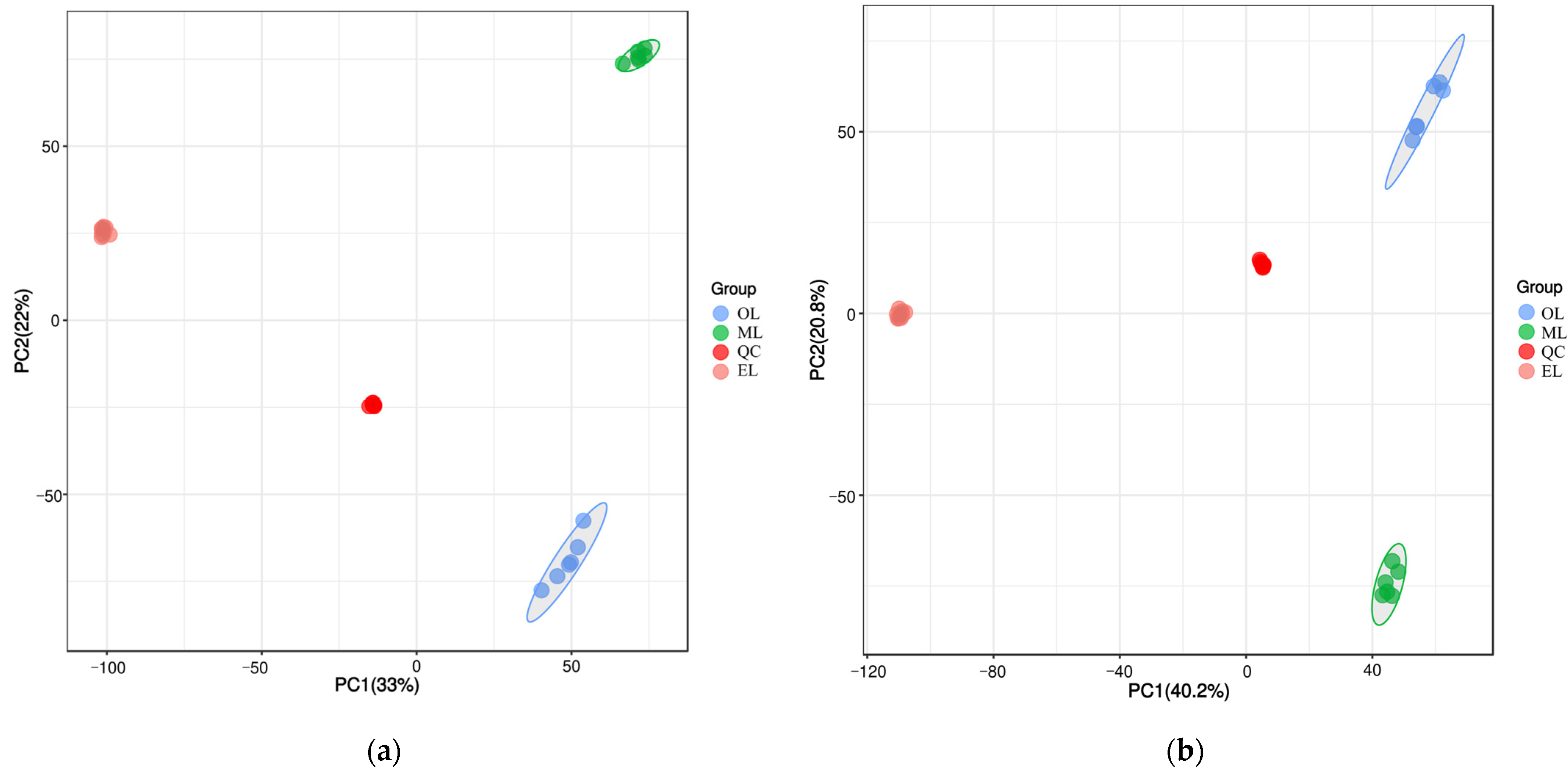

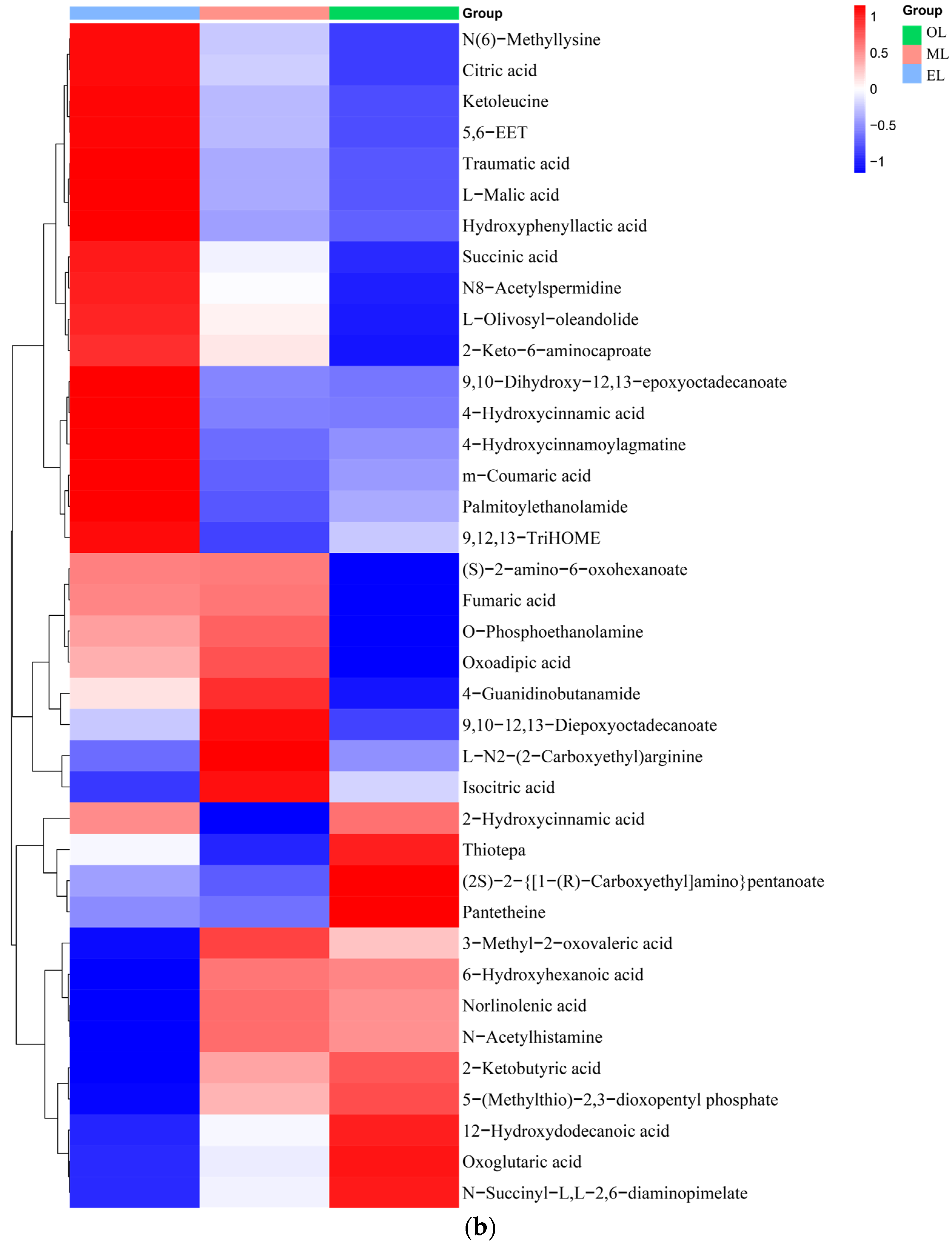

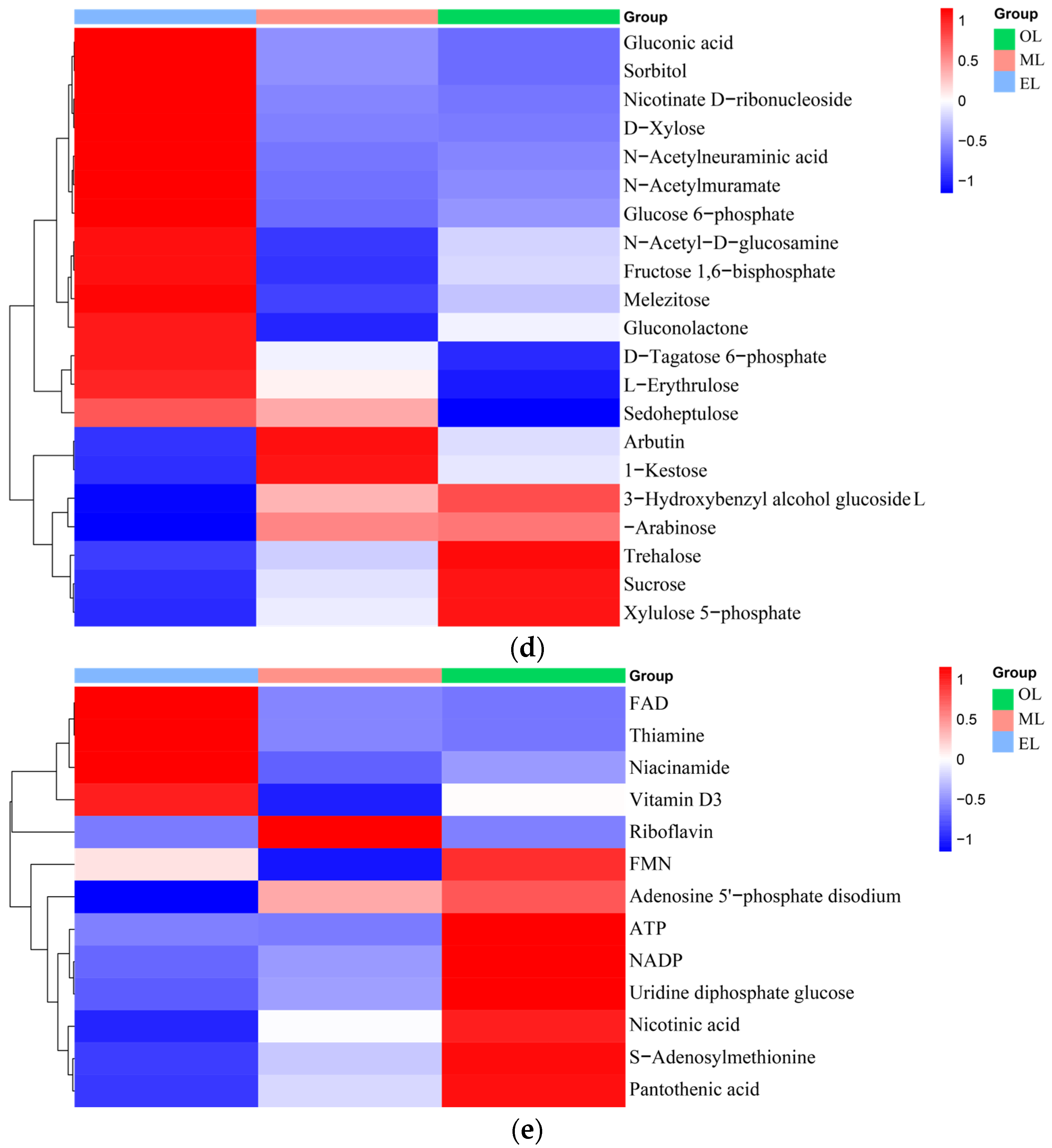

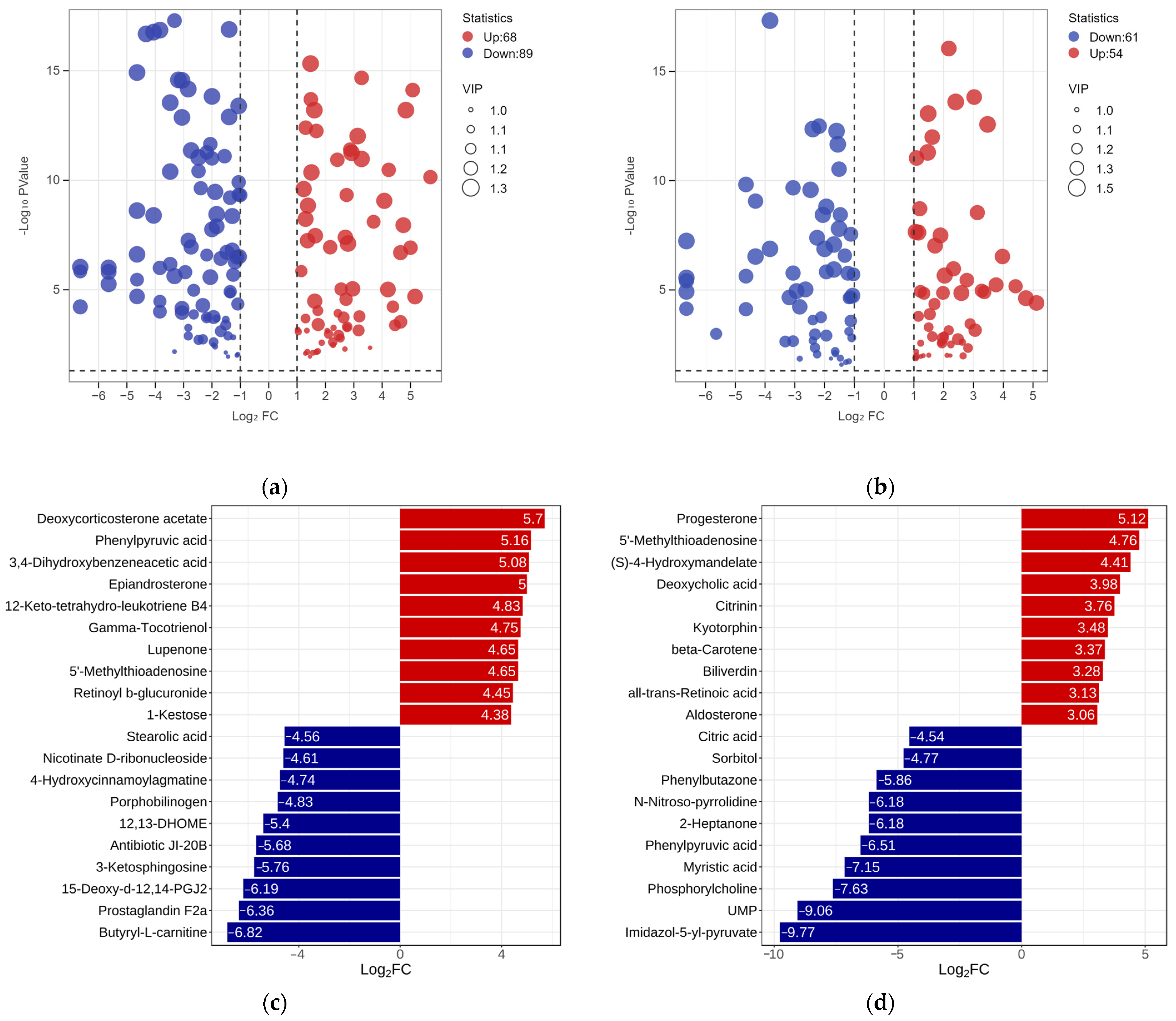
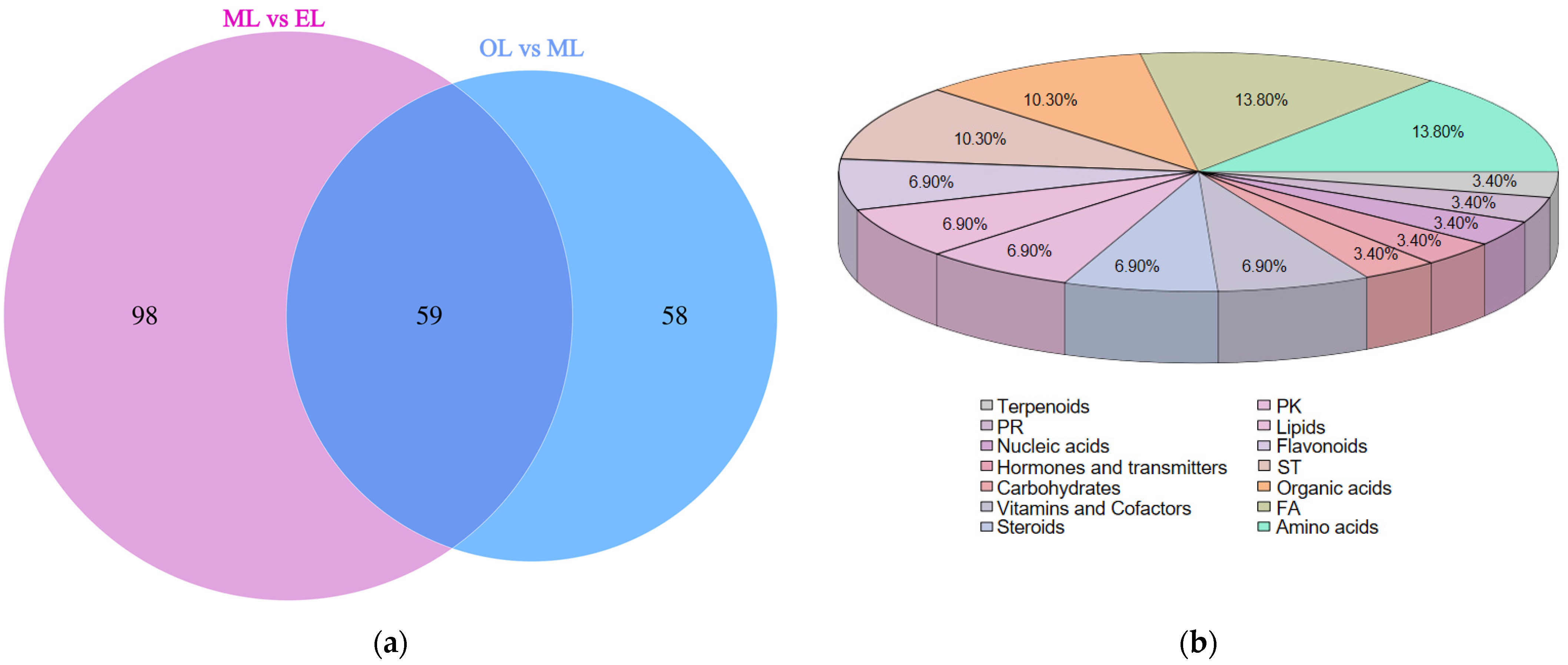
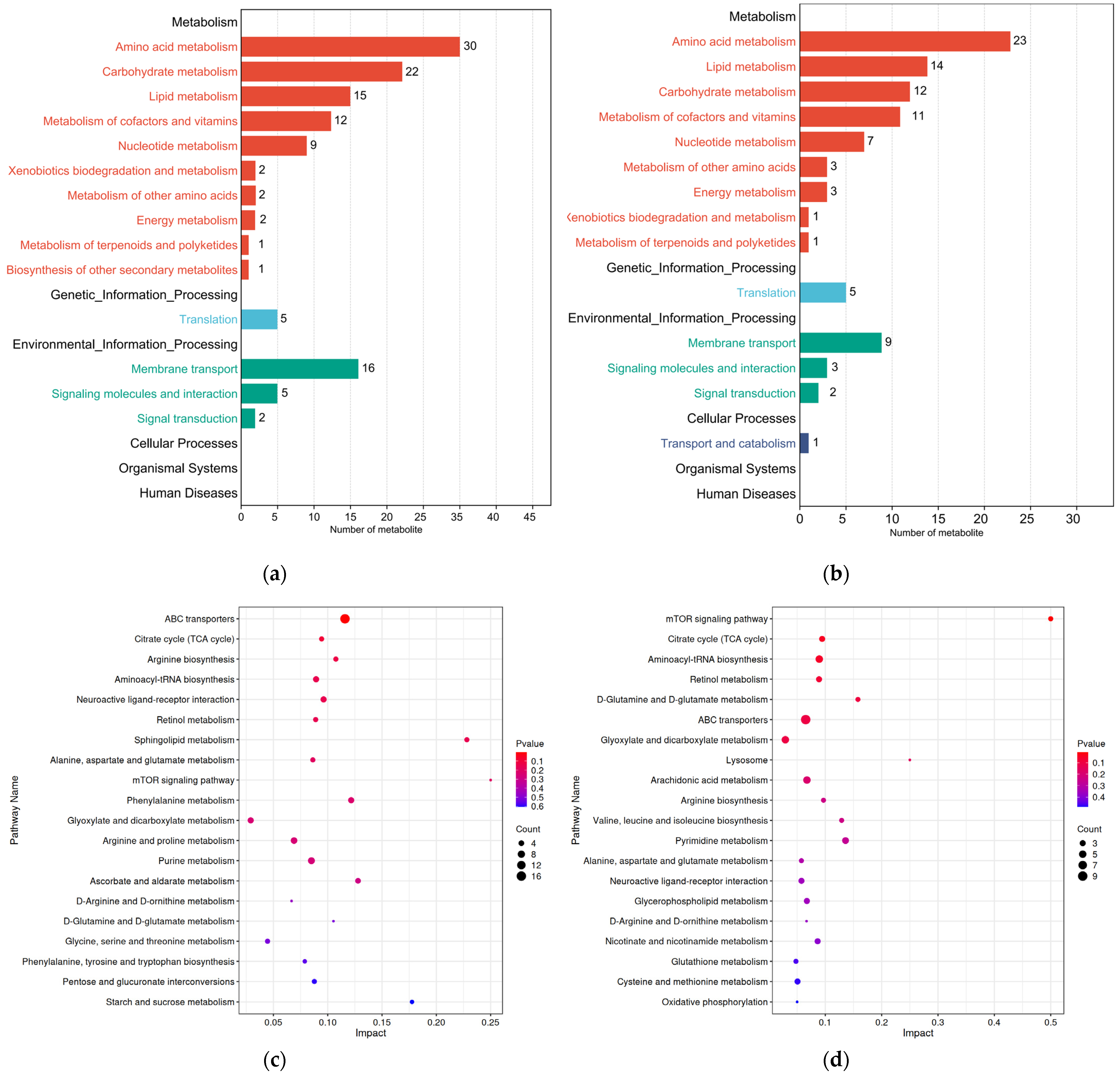
| EL | ML | OL | |
|---|---|---|---|
| Anthropometric property | |||
| Length (mm) | 1.55 ± 0.36 c | 3.23 ± 0.35 b | 4.99 ± 0.28 a |
| Weight (g) | 0.93 ± 0.22 c | 4.60 ± 0.88 b | 6.30 ± 0.58 a |
| Diameter (cm) | 0.53 ± 0.13 c | 1.33 ± 0.14 b | 1.56 ± 0.14 a |
| Head circumference (cm) | 0.17 ± 0.05 c | 0.43 ± 0.06 b | 0.63 ± 0.02 a |
| Chemical composition | |||
| Moisture (g/100 g, fw) | 80.70 ± 0.34 a | 59.95 ± 0.05 b | 57.16 ± +0.67 c |
| Ash (g/100 g, dw) | 3.59 ± 0.44 a | 2.22 ± 0.09 b | 2.17 ± 0.15 b |
| Protein (g/100 g, dw) | 53.87 ± 0.20 a | 34.23 ± 0.17 b | 32.10 ± 0.21 c |
| Fat (g/100 g, dw) | 18.55 ± 0.18 c | 67.95 ± 0.39 a | 58.45 ± 0.84 b |
| Total phenolic content (mg GAE/g, dw) | 21.10 ± 0.06 a | 6.07 ± 0.16 b | 4.47 ± 0.04 c |
| EL | ML | OL | |
|---|---|---|---|
| EAA | 25.27 ± 1.16 b | 26.28 ± 1.17 a | 19.46 ± 0.95 c |
| His | 1.72 ± 0.08 a | 1.72 ± 0.15 a | 1.29 ± 0.09 b |
| Met | 0.68 ± 0.16 c | 1.00 ± 0.03 a | 0.81 ± 0.04 b |
| Val | 3.76 ± 0.15 b | 4.08 ± 0.10 a | 3.05 ± 0.24 c |
| Ile | 2.72 ± 0.20 b | 3.19 ± 0.22 a | 2.44 ± 0.11 c |
| Leu | 4.89 ± 0.13 a | 4.88 ± 0.08 b | 3.55 ± 0.30 c |
| Phe | 2.77 ± 0.13 b | 2.83 ± 0.22 a | 2.28 ± 0.09 c |
| Thr | 2.88 ± 0.15 b | 3.04 ± 0.06 a | 2.29 ± 0.02 c |
| Lys | 5.84 ± 0.17 a | 5.54 ± 0.57 b | 3.76 ± 0.18 c |
| NEAA | 36.28 ± 0.69 b | 40.26 ± 1.33 a | 29.18 ± 0.65 c |
| Cys | 0.16 ± 0.05 c | 0.46 ± 0.03 b | 0.53 ± 0.12 a |
| Tyr | 2.85 ± 0.45 b | 3.14 ± 0.36 a | 2.14 ± 0.30 c |
| Asp | 5.04 ± 0.70 b | 6.53 ± 0.17 a | 4.82 ± 0.21 c |
| Ser | 2.84 ± 0.16 b | 3.18 ± 0.11 a | 2.71 ± 0.13 c |
| Glu | 9.88 ± 0.11 a | 9.75 ± 0.37 b | 6.86 ± 0.11 c |
| Gly | 3.06 ± 0.3 c | 3.62 ± 0.19 a | 3.07 ± 0.21 b |
| Ala | 4.39 ± 0.06 b | 4.42 ± 0.28 a | 3.26 ± 0.11 c |
| Arg | 4.19 ± 0.23 a | 4.14 ± 0.05 b | 3.10 ± 0.20 c |
| Pro | 3.86 ± 0.12 b | 5.01 ± 0.40 a | 2.68 ± 0.34 c |
| TAA | 61.55 ± 1.56 b | 66.54 ± 2.44 a | 48.64 ± 1.60 c |
| EAA/TAA (%) | 41.05 ± 0.94 a | 39.49 ± 0.46 c | 40.00 ± 0.65 b |
| EAA/NEAA (%) | 69.67 ± 2.73 a | 65.27 ± 1.25 c | 66.69 ± 1.79 b |
| Fatty Acids | EL | ML | OL |
|---|---|---|---|
| Caprylic acid (C8:0) | 0.11 ± 0.00 b | 0.15 ± 0.02 b | 0.37 ± 0.12 a |
| Capric acid (C10:0) | 0.10 ± 0.00 b | 0.13 ± 0.02 b | 0.32 ± 0.09 a |
| Lauric acid (C12:0) | 0.86 ± 0.01 b | 1.09 ± 0.18 b | 2.65 ± 0.76 a |
| Myristic acid (C14:0) | 1.65 ± 0.01 b | 1.69 ± 0.06 b | 2.21 ± 0.28 a |
| Palmitic acid (C16:0) | 43.01 ± 0.07 a | 41.41 ± 0.63 b | 39.57 ± 0.41 c |
| Palmitoleic acid (C16:1) | 6.01 ± 0.03 a | 5.53 ± 0.11 c | 5.82 ± 0.09 b |
| Stearic acid (C18:0) | 1.80 ± 0.03 b | 2.10 ± 0.01 a | 1.68 ± 0.05 c |
| Oleic acid (C18:1) | 45.56 ± 0.10 b | 46.79 ± 0.39 a | 45.22 ± 0.81 b |
| Linoleic acid (C18:2 n6) | 0.51 ± 0.03 b | 0.54 ± 0.01 b | 1.31 ± 0.02 a |
| α-Linolenic acid (C18:3 n3) | 0.11 ± 0.01 c | 0.17 ± 0.00 b | 0.24 ± 0.00 a |
| Behenic acid (C22:0) | 0.30 ± 0.00 a | 0.31 ± 0.00 a | 0.2 ± 0.03 b |
| Nervonic acid (C24:1) | ND | 0.1 ± 0.00 b | 0.42 ± 0.02 a |
| SFA | 47.83 ± 0.01 a | 46.88 ± 0.00 b | 46.99 ± 0.14 b |
| UFA | 52.17 ± 0.03 c | 53.12 ± 0.01 a | 53.01 ± 0.63 b |
| MUFA | 51.56 ± 0.76 b | 52.42 ± 0.01 a | 51.46 ± 0.81 c |
| PUFA | 0.62 ± 0.00 c | 0.71 ± 0.00 b | 1.55 ± 0.00 a |
| PUFA/SFA | 0.01 ± 0.00 b | 0.01 ± 0.00 b | 0.03 ± 0.00 a |
| n-6/n-3 | 4.67 ± 0.25 b | 3.19 ± 0.05 c | 5.50 ± 0.05 a |
| Mineral | EL | ML | OL |
|---|---|---|---|
| Macrominerals | |||
| Potassium | 15,865.04 ± 76.76 a | 10,568.25 ± 117.74 b | 5707.12 ± 33.35 c |
| Phosphorus | 7728.37 ± 91.87 a | 4166.53 ± 41.22 b | 2123.87 ± 12.51 c |
| Magnesium | 2030.59 ± 15.54 a | 1942.75 ± 46.37 b | 1123.21 ± 1.32 c |
| Sodium | 1907.21 ± 9.7 a | 1798.43 ± 41.64 b | 707.79 ± 3.25 c |
| Calcium | 700.73 ± 22.6 a | 594.84 ± 16.74 b | 341.86 ± 4.97 c |
| Microminerals | |||
| Zinc | 211.00 ± 4.87 a | 112.29 ± 4.56 b | 49.64 ± 1.11 c |
| Iron | 79.35 ± 3.23 a | 29.48 ± 0.86 b | 12.25 ± 0.67 c |
| Copper | 13.91 ± 0.3 a | 5.84 ± 0.01 b | 5.87 ± 0.04 b |
| Manganese | 10.47 ± 0.22 a | 7.16 ± 0.26 b | 4.34 ± 0.03 c |
| Chromium | 1.44 ± 0.09 a | 0.28 ± 0.02 b | 0.16 ± 0.03 c |
| Nickel | 1.18 ± 0.01 a | 0.67 ± 0.04 b | 0.08 ± 0.01 c |
| Arsenic | 0.07 ± 0.00 a | 0.05 ± 0.00 a | 0.01 ± 0.00 b |
| Cadmium | 0.33 ± 0.01 a | 0.09 ± 0.00 b | 0.02 ± 0.00 c |
| Lead | 0.16 ± 0.01 a | 0.14 ± 0.00 a | 0.01 ± 0.00 b |
| Name | Number | Proportion% |
|---|---|---|
| Lipids and lipid-like molecules | 87 | 27.02 |
| Organic acids and derivatives | 79 | 24.53 |
| Organoheterocyclic compounds | 48 | 14.91 |
| Organic oxygen compounds | 33 | 10.25 |
| Benzenoids | 30 | 9.32 |
| Organic nitrogen compounds | 15 | 4.66 |
| Phenylpropanoids and polyketides | 14 | 4.35 |
| Nucleosides, nucleotides, and analogues | 13 | 4.04 |
| Alkaloids and derivatives | 2 | 0.62 |
| Homogeneous non-metal compounds | 1 | 0.31 |
| Total | 322 | 100 |
| Radicals | Samples | EL | ML | OL | |
|---|---|---|---|---|---|
| EC50 value | DPPH | Water extract | 1.12 ± 0.01 c | 3.94 ± 0.02 a | 1.88 ± 0.01 b |
| Ethanol extract | 15.35 ± 0.03 c | 25.83 ± 0.17 b | 27.69 ± 0.01 a | ||
| Hydroxyl | Water extract | 11.23 ± 0.01 c | 16.02 ± 0.06 b | 17.73 ± 0.04 a | |
| Ethanol extract | 58.12 ± 0.03 a | 36.47 ± 0.08 c | 39.43 ± 0.12 b | ||
| ABTS | Water extract | 2.52 ± 0.17 c | 6.22 ± 0.70 a | 4.86 ± 0.35 b | |
| Ethanol extract | 17.42 ± 0.29 c | 49.63 ± 0.81 a | 45.13 ± 0.26 b |
Disclaimer/Publisher’s Note: The statements, opinions and data contained in all publications are solely those of the individual author(s) and contributor(s) and not of MDPI and/or the editor(s). MDPI and/or the editor(s) disclaim responsibility for any injury to people or property resulting from any ideas, methods, instructions or products referred to in the content. |
© 2024 by the authors. Licensee MDPI, Basel, Switzerland. This article is an open access article distributed under the terms and conditions of the Creative Commons Attribution (CC BY) license (https://creativecommons.org/licenses/by/4.0/).
Share and Cite
Chen, M.; Kan, J.; Zhang, Y.; Zhao, J.; Lv, C.; Zhong, B.; Li, C.; Qin, W. Combined Analysis of Metabolomics and Biochemical Changes Reveals the Nutritional and Functional Characteristics of Red Palm Weevil Rhynchophus ferrugineus (Coleoptera: Curculionidae) Larvae at Different Developmental Stages. Insects 2024, 15, 294. https://doi.org/10.3390/insects15040294
Chen M, Kan J, Zhang Y, Zhao J, Lv C, Zhong B, Li C, Qin W. Combined Analysis of Metabolomics and Biochemical Changes Reveals the Nutritional and Functional Characteristics of Red Palm Weevil Rhynchophus ferrugineus (Coleoptera: Curculionidae) Larvae at Different Developmental Stages. Insects. 2024; 15(4):294. https://doi.org/10.3390/insects15040294
Chicago/Turabian StyleChen, Mengran, Jintao Kan, Yufeng Zhang, Jinhao Zhao, Chaojun Lv, Baozhu Zhong, Chaoxu Li, and Weiquan Qin. 2024. "Combined Analysis of Metabolomics and Biochemical Changes Reveals the Nutritional and Functional Characteristics of Red Palm Weevil Rhynchophus ferrugineus (Coleoptera: Curculionidae) Larvae at Different Developmental Stages" Insects 15, no. 4: 294. https://doi.org/10.3390/insects15040294





